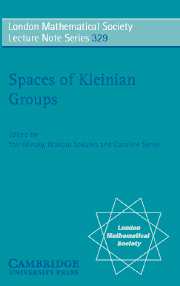Book contents
- Frontmatter
- Contents
- Preface
- Drilling short geodesics in hyperbolic 3-manifolds
- On topologically tame Kleinian groups with bounded geometry
- An extension of the Masur domain
- Thurston's bending measure conjecture for once punctured torus groups
- Complexity of 3-manifolds
- Moduli of continuity of Cannon–Thurston maps
- Variations of McShane's identity for punctured surface groups
- Train tracks and the Gromov boundary of the complex of curves
- The pants complex has only one end
- The Weil–Petersson geometry of the five-times punctured sphere
- Convexity of geodesic-length functions: a reprise
- A proof of the Ahlfors finiteness theorem
- On the automorphic functions for Fuchsian groups of genus two
- Boundaries for two-parabolic Schottky groups
- Searching for the cusp
- Circle packings on surfaces with projective structures: a survey
- Grafting and components of quasi-fuchsian projective structures
- Computer experiments on the discreteness locus in projective structures
On topologically tame Kleinian groups with bounded geometry
Published online by Cambridge University Press: 05 November 2011
- Frontmatter
- Contents
- Preface
- Drilling short geodesics in hyperbolic 3-manifolds
- On topologically tame Kleinian groups with bounded geometry
- An extension of the Masur domain
- Thurston's bending measure conjecture for once punctured torus groups
- Complexity of 3-manifolds
- Moduli of continuity of Cannon–Thurston maps
- Variations of McShane's identity for punctured surface groups
- Train tracks and the Gromov boundary of the complex of curves
- The pants complex has only one end
- The Weil–Petersson geometry of the five-times punctured sphere
- Convexity of geodesic-length functions: a reprise
- A proof of the Ahlfors finiteness theorem
- On the automorphic functions for Fuchsian groups of genus two
- Boundaries for two-parabolic Schottky groups
- Searching for the cusp
- Circle packings on surfaces with projective structures: a survey
- Grafting and components of quasi-fuchsian projective structures
- Computer experiments on the discreteness locus in projective structures
Summary
Abstract
We consider a generalisation of Minsky's rigidity theorem for freely indecomposable Kleinian groups with bounded geometry to topologically tame freely decomposable case in order to apply it to the following two results. The first is the uniqueness property for the problem of realising given end invariants by a group lying on the boundary of the quasi-conformal deformation space of a convex cocompact group. The second is a generalisation of Soma's result on the third bounded cohomology groups of closed surface groups to the case of free groups.
Introduction
A topologically tame hyperbolic 3-manifold has three pieces of information: the homeomorphism type, the conformal structures at infinity for geometrically finite ends (of non-cuspidal part), and the ending laminations for geometrically infinite ends. The ending lamination conjecture, due to Thurston, says that these pieces of information uniquely determine the isometry type of the manifold. Recently, Minsky proved this conjecture affirmatively, partially collaborating with Brock and Canary. Although the result is in the process of publication, the special case when manifolds have freely indecomposable fundamental group and bounded geometry, i.e., when the injectivity radii are bounded below by a positive constant, has been already published in [Min94], [Min00] and [Min01]. In the present paper, we shall explain how the argument of Minsky there can be generalised to the case of topologically tame manifolds with bounded geometry possibly with freely decomposable fundamental groups, and then show the following two kinds of its applications.
- Type
- Chapter
- Information
- Spaces of Kleinian Groups , pp. 29 - 48Publisher: Cambridge University PressPrint publication year: 2006
- 2
- Cited by



